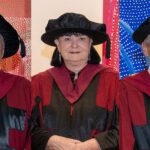A Curtin University mechatronics student selected for a six month research internship with NASA’s Jet Propulsion Laboratory (JPL) in California has spent the time learning to build disposable folding robots which may be deployed on future planetary missions.
Chris Norman, who is in his fourth year of a Bachelor of Engineering degree, began the internship in Pasadena in January this year and was invited to work on the mechanical design of a folding robot the size of a smartphone, designed to cover surface areas that a future Mars rover is unable to reach.
Mr Norman, who returned to Perth recently, said the internship was an incredible experience and he was honoured to be selected to contribute to a project which could potentially be used on future NASA missions.
“My role over the six months was to contribute to the mechanical design of the folding robot and assist with the pop-up feature, which allows the disposable robots to move across the rough and dangerous areas on Mars,” Mr Norman said.
“The robot itself was designed with a mechanical tail, which allowed the robot to flip itself over and charge the solar panels that were placed on the front of the robot.”
It is anticipated that future evolutions of the folding robots will be used on future planetary missions.
Dr Jonathan Paxman, from the School of Civil and Mechanical Engineering, said the internship was an incredible opportunity for students to participate in real research in one of the most highly regarded research facilities in the world for robotics and planetary exploration.
“There is the very real chance that something they work on at JPL will one day be part of an interplanetary mission, and that is incredibly exciting,” Dr Paxman said.
“For Curtin, it provides a validation of the research skills we teach, and of the outstanding capabilities of our best students.”
The internship was established through Curtin University in late 2015, after an approach by 2002 Curtin Mechatronics graduate Robert Reid, who now works at JPL.
The internship was offered to third and fourth year science and engineering students and received an overwhelming response.
“We had 24 students apply, and a panel of academics shortlisted seven, then JPL selected two final students to travel to California for the internship,” Dr Paxman said.
The other intern, Physics and Electronic and Communication Engineering student Tom Paynter, worked on a drone project at JPL and is currently on academic exchange in Sweden.
Dr Paxman said the internships had facilitated invaluable cross-disciplinary learning, with Mr Norman gaining experience across a wide range of areas including mechanical, electronical and computer engineering.



